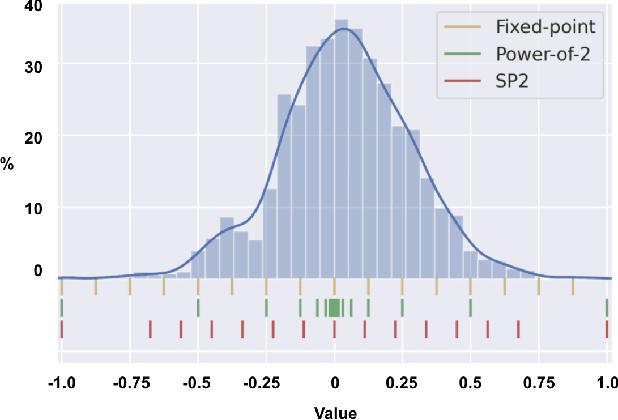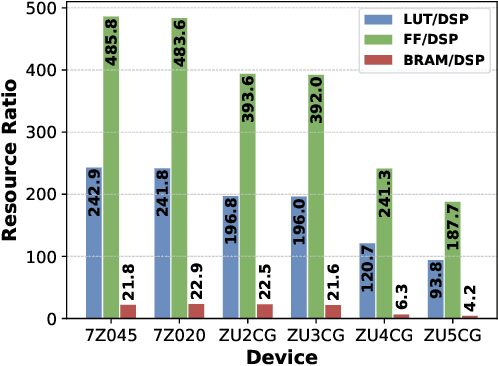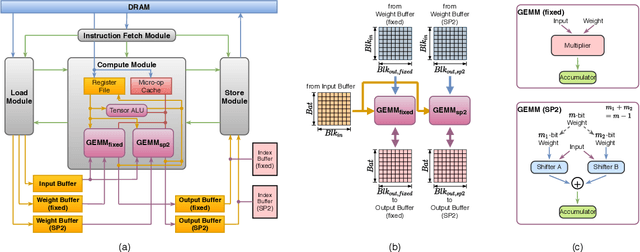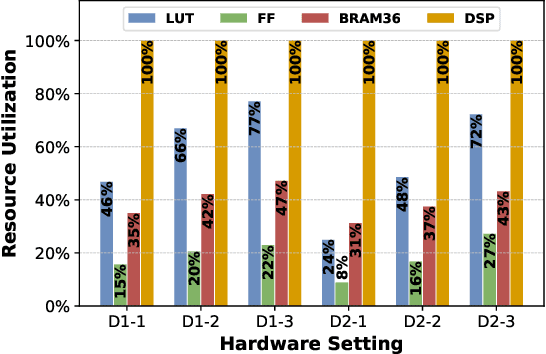Runbin Shi
Co-design Hardware and Algorithm for Vector Search
Jul 06, 2023Abstract:Vector search has emerged as the foundation for large-scale information retrieval and machine learning systems, with search engines like Google and Bing processing tens of thousands of queries per second on petabyte-scale document datasets by evaluating vector similarities between encoded query texts and web documents. As performance demands for vector search systems surge, accelerated hardware offers a promising solution in the post-Moore's Law era. We introduce \textit{FANNS}, an end-to-end and scalable vector search framework on FPGAs. Given a user-provided recall requirement on a dataset and a hardware resource budget, \textit{FANNS} automatically co-designs hardware and algorithm, subsequently generating the corresponding accelerator. The framework also supports scale-out by incorporating a hardware TCP/IP stack in the accelerator. \textit{FANNS} attains up to 23.0$\times$ and 37.2$\times$ speedup compared to FPGA and CPU baselines, respectively, and demonstrates superior scalability to GPUs, achieving 5.5$\times$ and 7.6$\times$ speedup in median and 95\textsuperscript{th} percentile (P95) latency within an eight-accelerator configuration. The remarkable performance of \textit{FANNS} lays a robust groundwork for future FPGA integration in data centers and AI supercomputers.
Mix and Match: A Novel FPGA-Centric Deep Neural Network Quantization Framework
Dec 12, 2020



Abstract:Deep Neural Networks (DNNs) have achieved extraordinary performance in various application domains. To support diverse DNN models, efficient implementations of DNN inference on edge-computing platforms, e.g., ASICs, FPGAs, and embedded systems, are extensively investigated. Due to the huge model size and computation amount, model compression is a critical step to deploy DNN models on edge devices. This paper focuses on weight quantization, a hardware-friendly model compression approach that is complementary to weight pruning. Unlike existing methods that use the same quantization scheme for all weights, we propose the first solution that applies different quantization schemes for different rows of the weight matrix. It is motivated by (1) the distribution of the weights in the different rows are not the same; and (2) the potential of achieving better utilization of heterogeneous FPGA hardware resources. To achieve that, we first propose a hardware-friendly quantization scheme named sum-of-power-of-2 (SP2) suitable for Gaussian-like weight distribution, in which the multiplication arithmetic can be replaced with logic shifter and adder, thereby enabling highly efficient implementations with the FPGA LUT resources. In contrast, the existing fixed-point quantization is suitable for Uniform-like weight distribution and can be implemented efficiently by DSP. Then to fully explore the resources, we propose an FPGA-centric mixed scheme quantization (MSQ) with an ensemble of the proposed SP2 and the fixed-point schemes. Combining the two schemes can maintain, or even increase accuracy due to better matching with weight distributions.
MSP: An FPGA-Specific Mixed-Scheme, Multi-Precision Deep Neural Network Quantization Framework
Sep 16, 2020



Abstract:With the tremendous success of deep learning, there exists imminent need to deploy deep learning models onto edge devices. To tackle the limited computing and storage resources in edge devices, model compression techniques have been widely used to trim deep neural network (DNN) models for on-device inference execution. This paper targets the commonly used FPGA (field programmable gate array) devices as the hardware platforms for DNN edge computing. We focus on the DNN quantization as the main model compression technique, since DNN quantization has been of great importance for the implementations of DNN models on the hardware platforms. The novelty of this work comes in twofold: (i) We propose a mixed-scheme DNN quantization method that incorporates both the linear and non-linear number systems for quantization, with the aim to boost the utilization of the heterogeneous computing resources, i.e., LUTs (look up tables) and DSPs (digital signal processors) on an FPGA. Note that all the existing (single-scheme) quantization methods can only utilize one type of resources (either LUTs or DSPs for the MAC (multiply-accumulate) operations in deep learning computations. (ii) We use a quantization method that supports multiple precisions along the intra-layer dimension, while the existing quantization methods apply multi-precision quantization along the inter-layer dimension. The intra-layer multi-precision method can uniform the hardware configurations for different layers to reduce computation overhead and at the same time preserve the model accuracy as the inter-layer approach.
Dynamic Sparse Training: Find Efficient Sparse Network From Scratch With Trainable Masked Layers
May 14, 2020



Abstract:We present a novel network pruning algorithm called Dynamic Sparse Training that can jointly find the optimal network parameters and sparse network structure in a unified optimization process with trainable pruning thresholds. These thresholds can have fine-grained layer-wise adjustments dynamically via backpropagation. We demonstrate that our dynamic sparse training algorithm can easily train very sparse neural network models with little performance loss using the same number of training epochs as dense models. Dynamic Sparse Training achieves the state of the art performance compared with other sparse training algorithms on various network architectures. Additionally, we have several surprising observations that provide strong evidence for the effectiveness and efficiency of our algorithm. These observations reveal the underlying problems of traditional three-stage pruning algorithms and present the potential guidance provided by our algorithm to the design of more compact network architectures.
 Add to Chrome
Add to Chrome Add to Firefox
Add to Firefox Add to Edge
Add to Edge